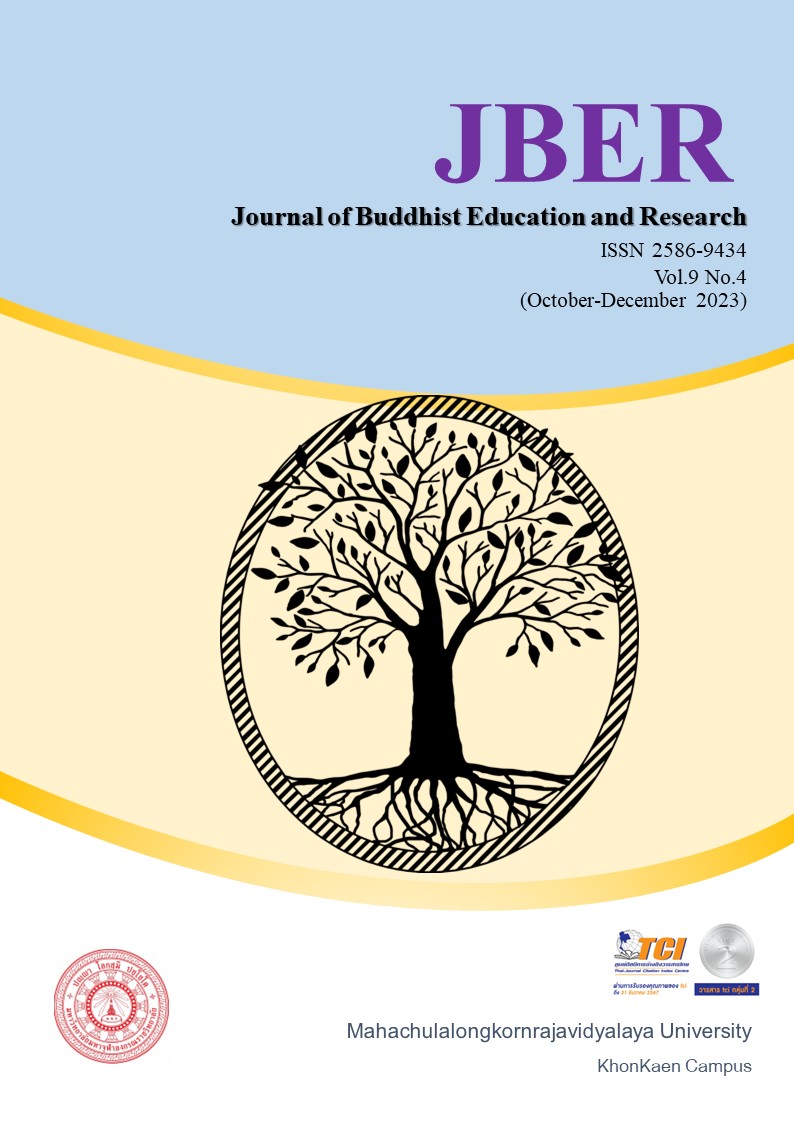The Learning Management Model for Preserving Thai History on Nakhon Phanom Miracle of Students Under the Nakhon Phanom Secondary Education Service Area
Keywords:
The Learning Management, Model for Preserving Thai History, Nakhon Phanom MiracleAbstract
The objectives of this research were: (1) to study the problems and ways to develop the learning management for preserving the Thai history on ‘the Nakhon Phanom Miracle’ of students under the Nakhon Phanom secondary education service area; (2) to develop the learning management model for preserving Thai history on Nakhon Phanom Miracle of students under the Nakhon Phanom secondary education service area; (3) to apply the developed model; (4) to study the effectiveness of the model. This research used the research and development research methods (R&D). The sample group of this research consisted of 109 students, 6 key informants, and 50 students in the target group. The statistics used in the research were: Percentage, Mean, Standard Deviation, and t-test (Dependent).
The research results were as follows:
1) The problematic level on the learning management for preserving Thai history on ‘the Nakhon Phanom Miracle’ of students under the Nakhon Phanom secondary education service area was statistically rated at the moderate level. The learning
management model for preserving the Thai history on ‘the Nakhon Phanom Miracle’ of students under the secondary education service area, Nakhon Phanom Province has the following components: (1) principles; (2) objectives; (3) content; (4) teaching methods; (5) measurement and evaluation.
2) The quality assessment of the learning management model for preserving Thai history on ‘the Nakhon Phanom Miracle’ of students under the secondary education service area, Nakhon Phanom Province Overall was at the highest level in terms of its appropriateness, accuracy, possibility, and the benefits of using the model for learning management to preserve Thai history.
3) The achievement test average score after using the learning management model to preserve Thai history on ‘the Nakhon Phanom Miracle’ of students under the secondary education service area, Nakhon Phanom Province was higher than before the study with a statistical significance level of .05.
4) The satisfaction of the fourth-year secondary school students at Ummomaprachasan School, That Phanom District, Nakhon Phanom Province with the learning management model was at a high level. The level of quality assessment of the learning management model was at the highest level.
References
กรมวิชาการ กระทรวงศึกษาธิการ. (2545). คู่มือการจัดสาระการเรียนรู้ กลุ่มสาระการเรียนรู้สังคม ศึกษาศาสนา และวัฒนธรรม. กรุงเทพฯ: โรงพิมพ์องค์การรับส่งสินค้าและพัสดุภัณฑ์,
กาญจนชนก ภัทรวนิชานันท์. “การวิเคราะห์องค์ประกอบสมรรถนะหลักเพื่อใช้ประเมินข้าราชการ กรณีศึกษา: สำนักงานคณะกรรมการข้าราชการครูและบุคลากรทางการศึกษา”. วารสาร บัณฑิตศึกษา มหาวิทยาลัยราชภัฎวไลยอลงกรณ์ในพระบรมราชูปภัมภ์. ปีที่ 5 ฉบับที่ 2 (พฤษภาคม-สิงหาคม 2554): 89-94.
ขวัญชฎิล พิศาลพงศ์. “กลยุทธ์การจัดการสารสนเทศภูมิปัญญาท้องถิ่น : ภารกิจของห้องสมุด
จุฑามาศ อนุกูลวรรธกะ ชรินทร์ มั่งคั่ง และแสวง แสนบุตร, “แนวทางการจัดกิจกรรมการเรียนรู้ ประวัติศาสตร์เพื่อส่งเสริมความเป็นพลเมืองชุมชนต้นแบบในการอนุรักษ์วัฒนธรรมท้องถิ่นของ นักเรียน ระดับชั้นมัธยมศึกษาตอนปลาย”, วารสารมนุษยศาสตร์และสังคมศาสตร์ มหาวิทยาลัยพะเยา, ปีที่ 9 ฉบับที่ 2 (กรกฎาคม–ธันวาคม 2564): 24.
จุฑามาศ อนุกูลวรรธกะ ชรินทร์ มั่งคั่ง และแสวง แสนบุตร. “แนวทางการจัดกิจกรรมการเรียนรู้
เฉลิม มลิลา นิติเขตต์ปรีชา. (2559). เทคนิคการสอนประวัติศาสตร์. พิมพ์ครั้งที่ 6. กรุงเทพฯ: โรงพิมพ์ แห่งจุฬาลงกรณ์มหาวิทยาลัย,
ทิศนา แขมมี และคณะ. (2559). ศาสตร์การสอนองค์ความรู้เพื่อการจัดกระบวนการเรียนรู้ที่มี ประสิทธิภาพ. กรุงเทพมหานคร: สำนักพิมพ์แห่งจุฬาลงกรณ์มหาวิทยาลัย,.
Journal of Buddhist Education and Research : JBER
ปีที่ 9 ฉบับที่ 4 ตุลาคม-ธันวาคม 2566 [328] Vol.9 No.4 October-December 2023
บุปผชาติ ทัฬหิกรณ์. (2552). การประยุกต์ใช้เทคโนโลยีสารสนเทศในการเรียนการสอน. กรุงเทพมหานคร: สำนักเทคโนโลยีเพื่อการเรียนการสอน สำนักงานคณะกรรมการการศึกษา ขั้นพื้นฐาน,
เบญญาภา คงมาลัย. (2554). “รูปแบบการพัฒนาสมรรถนะการจัดการความรู้ของนิสิตนักศึกษาระดับ ปริญญาบัณฑิต”. วิทยานิพนธ์ปรัชญาดุษฎีบัณฑิต. บัณฑิตวิทยาลัย: จุฬาลงกรณ์มหาวิทยาลัย.
พิมพันธ์ เดชะคุปต์และพเยาว์ ยินดีสุข. (2561). การจัดการเรียนรู้สังคมศึกษาในยุคศตวรรษที่ 21, กรุงเทพมหานคร: สำนักพิมพ์แห่งจุฬาลงกรณ์มหาวิทยาลัย.
ไพฑูรย์ สินลารัตน์ (2560). คิดผลิตภาพ: สอนและสร้างได้อย่างไร, กรุงเทพมหานคร: สำนักพิมพ์แห่ง จุฬาลงกรณ์มหาวิทยาลัย.
ไพฑูรย์ สินลารัตน์. (2560). โรงเรียน 4.0: โรงเรียนผลิตภาพ. กรุงเทพมหานคร: วิทยาลัยครุศาสตร์ มหาวิทยาลัยธุรกิจบัณฑิต..
วินัย พงศ์ศรีเพียร. (2543). คู่มือการจัดกิจกรรมการเรียนการสอนประวัติศาสตร์. กรุงเทพฯ: โรงพิมพ์ การศาสนา,
วิภาวรรณ พินลา และวิภาดา พินลา. (2561). การจัดการเรียนรู้เชิงรุกแบบรวมพลัง กับ PLC เพื่อการ พัฒนา. กรุงเทพมหานคร: สำนักพิมพ์แห่งจุฬาลงกรณ์มหาวิทยาลัย.
วิริยะ ฤาชัยพาณิชย์ และวรวรรณนิมิตพงษ์กุล. (2562). สอนสร้างสรรค์ เรียนสนุกยุค 4.0, (กรุงเทพมหานคร: บริษัท ซีเอ็ดยูเคชั่น จำกัด.
สหัทยา พลปัถพี และมูลนิธิพัฒน์, ทฤษฎี Constructionism: การศึกษาในโรงเรียน, [ออนไลน์], แหล่งที่มา: https://www.moe.go.th/moe/upload/news_research [30 กันยายน 2565].
สำนักงานคณะกรรมการการศึกษาขั้นพื้นฐาน. (2558). แนวการสอนประวัติศาสตร์: ประวัติศาสตร์ไทย
สำนักวิชาการและมาตรฐานการศึกษา. (2554). เพื่อนคู่คิด มิตรคู่ครู แนวทางการจัดกิจกรรมการเรียนรู้
หลากหลายวิธีเรียน. กรุงเทพฯ: โรงพิมพ์ชุมนุมสหกรณ์การเกษตรแห่งประเทศไทย จำกัด.
Anderson, T. P., “Using models of instruction”, In C. R. Dills and A. J. Romis Zowski (Eds.), (1997), Instructional development paradigms, Englewood Cliffs, (NJ: Education Technology Publications, pp. 521-533.
Joyce, B., Weil, M., & Calhoun, E. (2003). Models of teaching.





